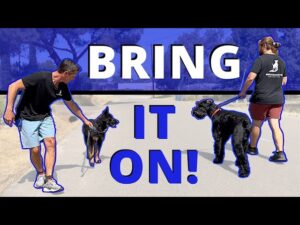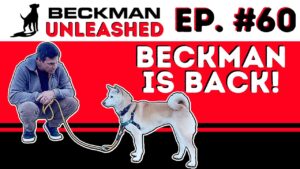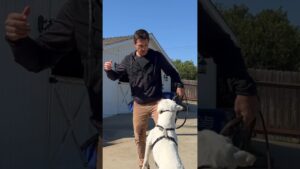
The Missing Link: Why Most Dog Trainers Cannot Fix Aggression.
Story Highlights:
- The author provides a solution for dog owners with reactive or aggressive dogs to socialize them with other dogs.
- The method involves finding a calm, big, happy, and not pushy dog to socialize with, and the use of tools such as muzzles,
- leashes, and fences to keep dogs safe.
- Starting with one dog and gradually adding more dogs is advised as the dog becomes more comfortable and desensitized.
- The author stresses the importance of fading off tools once the dog looks good and correcting any uncool behavior exhibited by
- the dog during the process.
- This solution can be implemented at home, and the author encourages more trainers and dog owners to adopt this approach to prevent reactive behavior and aggression toward other dogs.
Dog-on-dog aggression is a serious problem for many dog owners, often leading to a decrease in the dog’s quality of life and even euthanasia. While traditional dog training methods often involve the use of treats or shock collars, there is a more effective and humane approach that can be used to socialize reactive or aggressive dogs. In this blog, we will discuss a method that involves using one dog to help another overcome aggression towards other dogs.
The method of using one dog to help another overcome aggression towards other dogs involves finding a calm, big, happy, and not pushy dog to socialize with. It is essential to use tools such as muzzles, leashes, and fences to keep dogs safe during the initial stages of socialization. The author emphasizes the importance of fading off these tools once the dog looks good and correcting any uncool behavior exhibited by the dog during the process.
Starting with one dog and gradually adding more dogs is advised as the dog becomes more comfortable and desensitized. The author stresses the importance of allowing dogs to make friends, which will help to reduce their triggers and increase their happiness. By following the steps outlined in the video, dog owners can successfully socialize their reactive or aggressive dogs, thereby improving the dogs’ quality of life and reducing the likelihood of them being put down.
The method is straightforward yet effective and can be implemented at home, even if the owner lives in a country like Germany or Australia and cannot come to the author for training. The author provides a detailed example using their red Dobie, Vasco, to demonstrate how this process can be done effectively. The author encourages more trainers and dog owners to adopt this approach to prevent reactive behavior and aggression toward other dogs.
In conclusion, using one dog to help another overcome aggression towards other dogs is an effective and humane approach to socializing reactive or aggressive dogs. By finding a calm, big, happy, and not pushy dog to socialize with and using appropriate tools, dog owners can successfully socialize their dogs, thereby improving their quality of life and reducing the likelihood of them being put down. We encourage more trainers and dog owners to adopt this approach to prevent reactive behavior and aggression toward other dogs.
FAQs:
Q: How long does the process take to socialize a reactive or aggressive dog?
A: The process can take anywhere from several weeks to several months, depending on the dog’s individual temperament and the severity of the reactive or aggressive behavior.
Q: What if my dog does not respond well to the socialization process?
A: It is essential to understand that not all dogs are the same, and some may not respond well to the socialization process. In such cases, it may be necessary to seek the help of a professional dog trainer or behaviorist.
Q: Is it safe to use muzzles, leashes, and fences to keep dogs safe during the socialization process?
A: Yes, it is safe to use appropriate tools to keep dogs safe during the socialization process. Muzzles, leashes, and fences are commonly used to ensure that the dogs are not able to harm themselves or other dogs during the process. However, it is important to use these tools properly and ensure that the dog is comfortable and not distressed.
The author of the video emphasizes the gradual fading off of these tools once the dog has become comfortable and exhibits positive behavior towards other dogs. It is also important to monitor the dogs closely during socialization to prevent any unwanted behavior and ensure a safe and positive experience for all dogs involved.




